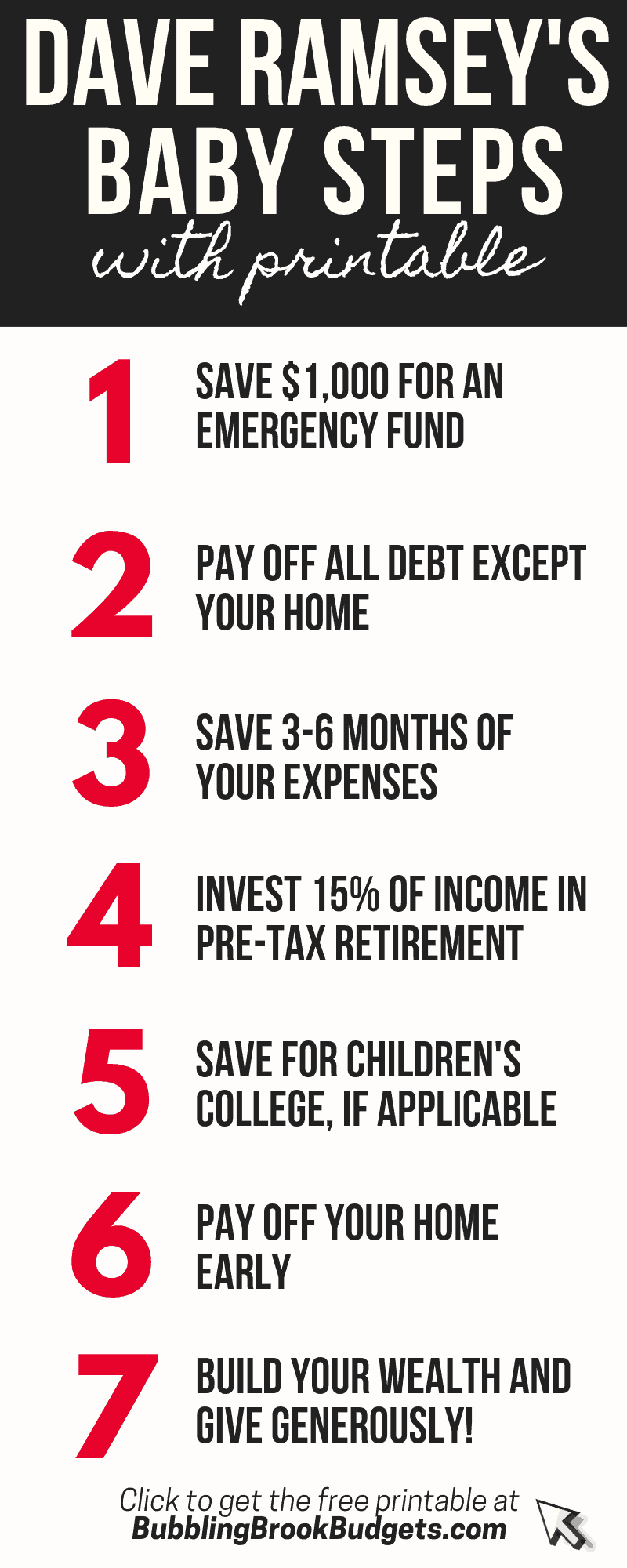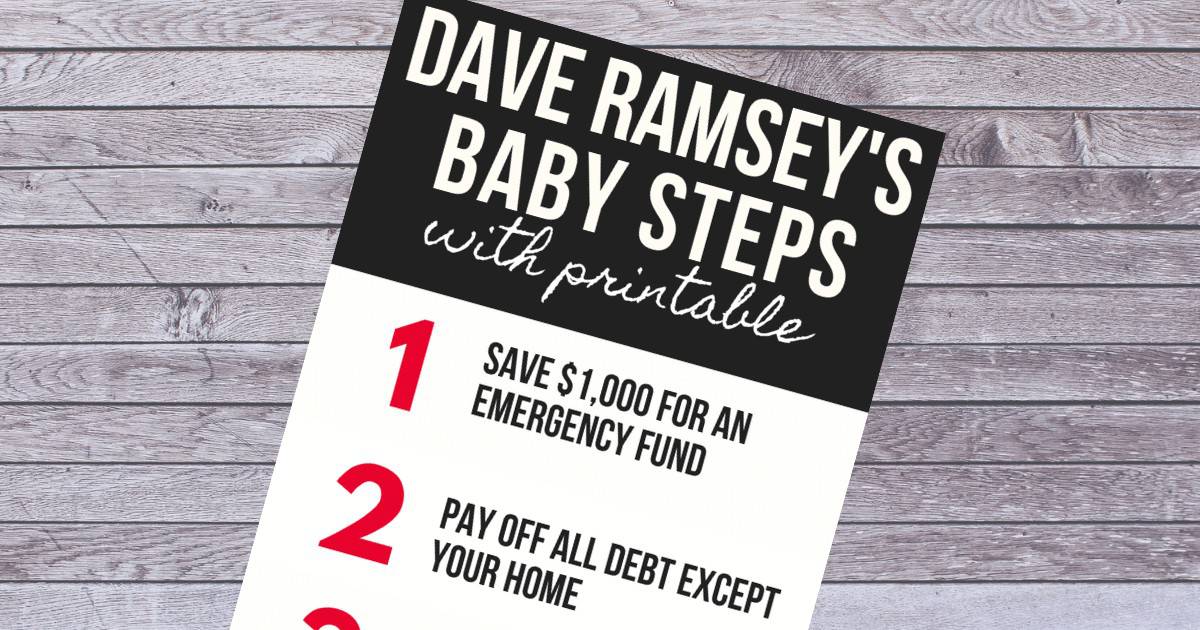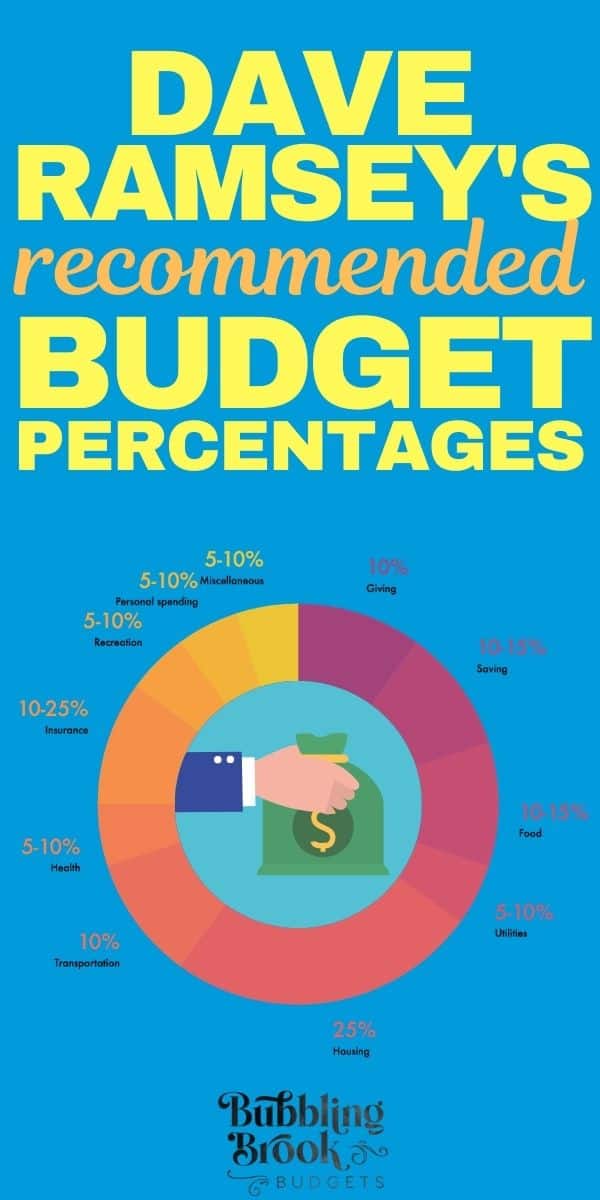We’re huge Dave Ramsey fans here in the Bubbling Brook community. If you aren’t familiar with his plan for financial freedom, let us introduce you to the 7 Dave Ramsey steps (or “baby steps” as he explains them).

At the bottom of this post, you can grab the Dave Ramsey steps printable version we created that lists all seven baby steps. It’s perfect for hanging up on your fridge or in your office, so you can keep your goal in front of you each day.
Related: Dave Ramsey Printables That’ll Help You Stay Motivated
The Total Money Makeover Book
Dave has authored several bestselling books, but his book The Total Money Makeover (TMM) has been pivotal in many people paying off their debts and beginning their debt free journey. In TMM, he outlines his seven baby steps in great detail. If you only get one of his books, it should be this one.
You can find this book at just about any bookstore or on Amazon (see the current price here). If money is tight, you can probably find it at your local library, or request that they get it in. Currently, the audio version is free on Amazon if you sign up for a trial with Audible. But, I’m a sucker for actual paper books that I can hold in my hand, refer back to often, and maybe even pass along to someone else who could use it.
The Total Money Makeover PDF download
Dave makes a portion of his TMM book available as a PDF download here. Recently, we also noticed that there is a free download of Total Money Makeover PDF, the full version. We aren’t sure if this is for a limited time, or if it will stay up indefinitely.
Now, without further ado…

The 7 Dave Ramsey Steps To Financial Freedom
Baby Step 1 – Save $1000 for your emergency fund.
Before you do anything else, Dave wants you to put $1000 away in case “Murphy moves in.” You’ll increase this amount later, but for now, focus on the $1000. Have a garage sale, sell on Poshmark or sell on Mercari, or deliver pizzas. Once you’ve completed this step, then it’s time to push up your sleeves and really get to work.
Related: My Dave Ramsey meal plan for a beans and rice budget
If you’d like to work on getting your household budget in line with Dave Ramsey’s recommended budget percentages, you can use this pie chart:

Baby Step 2 – Pay off all debt using the debt snowball method (except your home).
This is where things get intense — gazelle intense, as Dave says. Order your debts from smallest to largest, and begin putting all your extra money to the smallest debt first. Don’t pay attention to the interest rate or anything else, just push everything you can into the smallest debt while making only the minimum payments to the rest. Then, cross that debt out, and get to work on the next one.
During this portion of the Dave Ramsey steps many people will get side jobs (like Course Hero or VIPkid) and drastically reduce their food expenditures. Dave recommends using a meal planning service like emeals (click here to try them for two weeks free) if you struggle with keeping your grocery budget in check.
Related: How we paid for Christmas one year by earning Amazon gift cards
Baby Step 3 – Save 3-6 months of your expenses.
After you’ve completed baby step 2, now you work on building up your emergency savings above that $1000 starter fund. Add up all your regular monthly expenses, and work on saving up 3x-6x that amount. If you’re job is very secure, maybe you’ll feel comfortable saving three months of expenses. On the other hand, if your job is a bit turbulent or you’re worried about the economy, then save six months of expenses.
As you work on increasing your savings, you might want to consider depositing the money into a high interest account. CIT Bank is a reputable online bank with high interest rates (check out their money market savings account), or you might shop around for a good rate at a local community bank.
Baby Step 3b – Save for a down payment on a house (optional).
Dave Ramsey baby steps 3b isn’t an official step, but Dave and his team have mentioned it several times in various places (in this facebook post, for one example). Basically, this is a great place to begin saving for a down payment on a house, if buying a home is something you’d like to do.
How much of a down payment you’ll need is a decision you’ll have to make on your own, possibly with input from your mortgage lender. Consider saving enough of a down payment so that you can avoid paying PMI (mortgage insurance), which can add quite a bit to your monthly mortgage payment.
Related: 13 Things Dave Ramsey Fans Wish You Knew
Baby Step 4 – Invest 15% of your income into pre-tax and Roth IRA retirement accounts.
Of all the Dave Ramsey steps, this one is often overlooked, but it’s so important. You’ll want to send at least 15% of your income into your 401k, Roth IRA, etc. If you have an employer match for your 401k, that’s great! The more you can put away towards retirement, the better. Keep in mind there are annual maximum contributions for certain accounts. Check with your employer or your accountant.
Personally, we shoot for a much higher savings rate than the 15% Dave mentions in his plan. 15% is a starting point, especially if you’re young.
Note: There’s a cool worksheet for calculating your Personal Savings Rate included in my Budget Binder Toolkit. It’s a great tool for comparing your progress each month or quarter!
Baby Step 5 – Save for college.
If you have children and plan to pay for their college, do that during baby step 5. Many states offer special plans and incentives to assist you with this, such as a 529 plan.
Baby Step 6 – Pay off your home early.
This is the most debated of all the Dave Ramsey steps. Some argue that you’re better off investing any extra money rather than socking it to your mortgage. Dave argues that they aren’t considering RISK, and that there’s a confidence you get once your home is paid for and totally yours. We agree with him.
You can read our story of how we paid off our home, here.
Baby Step 7 – Build wealth and give.
We think this is the most exciting of all the Dave Ramsey steps! Once you get to baby step 7, you can truly live and GIVE like no one else. Continue to build your wealth, but also give generously.
Whether you give publicly or in secret is up to you. Look for needs around you, maybe among people you know personally or within your community. What causes do you believe in? When you give money, you are “voting with your dollars.” What are you voting for? What would you like to see more of? Who do you want to help?
** Click here to grab our free printable of Dave Ramsey’s baby steps **
Tell us — which of the Dave Ramsey steps are you on? We’d love to know!
Let’s chat soon,

New to my site? I love to share ways to get out of debt, save more money, and cook cheap healthy meals from home.
A few tools we recommend:
Personal Capital – It’s a helpful (and FREE!) way to track your spending, income, and entire investment portfolio all in one place. Check them out here.
Use a shopping portal like Ebates and save more money on everything you buy online. Get a $10 bonus when you sign up now.
Give eMeals a try. This is the meal planning service Dave Ramsey recommends on his show. For a small fee, they’ll even send your meal plan and shopping list over to a local store (like WalMart!) and have your groceries ready for you to just pick-up and go. Click here to try it free for 14 days.
I also highly recommend getting started with a pencil and paper budget, if you’re not already doing so. My printable Budget Binder Toolkit has everything you need to hit the ground running!



Leave a Reply